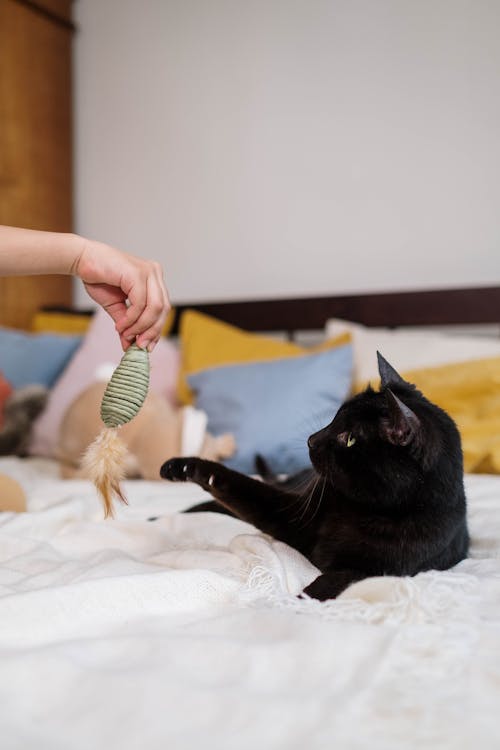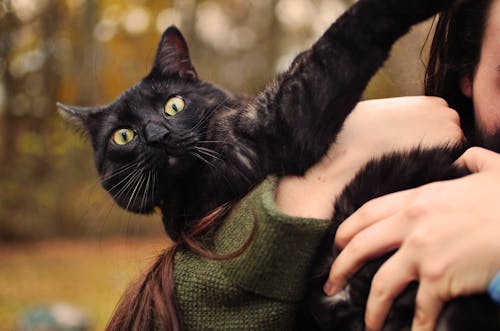Training a cat might seem like a daunting task, especially when compared to the eager responsiveness of dogs. Cats are often viewed as independent and aloof, but with the right approach, you can teach your feline friend simple commands like “shake,” “come here,” and “no.” Here’s a guide to help you train your cat effectively while fostering a strong bond between you two.

To teach your cat to shake hands, begin by preparing some treats. Choose a few of your cat’s favorite freeze-dried snacks or regular cat treats. The next step involves enticing your cat with these tasty morsels. While saying “shake hands,” bring the treat close to your cat, encouraging them to approach. As your cat leans in to sniff the food, gradually raise your hand to prompt them to extend their paw. When your cat reaches out with their paw to grab the treat, gently hold their paw in your hand while repeating the command “shake hands.” At the same time, reward them by placing the treat directly in their mouth.
To solidify this training, you’ll need to repeat these steps several times. This reinforcement will help your cat associate the action of shaking hands with receiving a treat. Once your cat understands this connection, you won't need to use treats every time. Instead, you can start to rely on praise and affection as rewards.
Moving on to teaching your cat to come when called, begin again with your cat’s favorite food. From a short distance, call your cat's name. When they look at you, show them the treat to capture their attention. Use the treat to coax your cat closer while repeating the command “come here.” Once they reach you, reward them with the treat and some gentle petting. Gradually increase the distance between you and your cat while maintaining the same process. This will teach your cat that coming to you results in rewards, encouraging them to respond even from further away.
Training your cat to understand what is not allowed is also important. For this, prepare a spray bottle filled with water. Whenever your cat engages in naughty behavior—such as chewing on cords, scratching the furniture, or biting—firmly say “no” while giving a light spray of water on their face. It’s crucial to remain calm and not engage further. Consistency is key here; each time your cat exhibits unwanted behavior, use the same method to reinforce the idea that such actions are not acceptable.
While training your cat, there are several factors to keep in mind to ensure effective results. First, pay attention to the length of each training session. Cats can become easily frustrated or disinterested, particularly those with more independent personalities. Aim for sessions of about ten minutes and always observe your cat’s mood. If they begin to resist or show signs of stress, it’s best to stop the session.
The optimal time to start training is when your cat is between two to three months old. At this stage, their personality and habits are still developing, and they possess a natural curiosity that makes them more receptive to learning new behaviors.
Finally, patience is essential throughout the training process. Be clear and consistent with your rewards and corrections, especially during the initial phases of training. When your cat responds correctly to a command, be sure to reward them with a treat, gentle petting, or verbal praise to encourage positive reinforcement.
By following these steps, you can train your cat to respond to commands effectively, creating a more harmonious relationship with your feline companion. With time, patience, and consistency, your cat will become a well-mannered member of the family, capable of following basic commands while enjoying the rewards of a loving partnership.

To further enhance your cat training experience, consider incorporating some additional strategies and techniques that can make the process even more effective. One crucial aspect of training is to establish a consistent routine. Cats thrive on predictability, and having regular training sessions at the same time each day can help reinforce the behaviors you're teaching. This routine not only helps your cat learn but also strengthens the bond between you and your pet, as they come to anticipate these positive interactions.
Another important factor is the environment in which you train your cat. Choose a quiet, distraction-free space where your cat feels comfortable and safe. A calm environment allows your cat to focus better on the training and reduces the likelihood of them becoming overwhelmed or distracted by outside stimuli. Once your cat has mastered certain commands in a controlled environment, you can gradually introduce distractions or change locations to test their training in various settings.
Using positive reinforcement is a fundamental principle in cat training. Beyond treats, you can also use toys, affection, or praise as rewards. Pay attention to what motivates your cat the most. For some cats, a favorite toy or a few minutes of playtime might be more enticing than food. Tailoring the rewards to your cat’s preferences can make training sessions more enjoyable for both of you.
Socialization is another vital component of a well-rounded cat training approach. Exposing your cat to different people, pets, and environments can help them become more adaptable and less fearful of new experiences. This exposure can also improve their behavior during training, as a well-socialized cat is generally more confident and less likely to react negatively to unfamiliar situations.
Additionally, consider incorporating clicker training into your sessions. Clicker training involves using a small handheld device that makes a distinct sound when pressed. This sound serves as a marker to indicate the exact moment your cat performs the desired behavior. After clicking, you immediately follow up with a reward. This method provides clear communication and helps your cat understand precisely which behavior is being reinforced.
It’s also essential to be aware of your cat's body language and vocalizations during training. Cats communicate a great deal through their body language, and understanding their signals can help you adjust your training methods accordingly. For instance, if your cat appears anxious or agitated, it might be a sign to take a break or change your approach. Recognizing these cues allows you to create a more positive training experience that respects your cat’s comfort levels.
Lastly, remember that training is a journey, not a race. Each cat is unique, with their own personality and learning pace. Celebrate small victories along the way and be patient with setbacks. Training takes time and persistence, and the bond you build with your cat during this process is as valuable as the commands they learn.
By integrating these strategies into your cat training sessions, you can foster a positive learning environment and deepen your relationship with your feline companion. With dedication, understanding, and a little creativity, you’ll be well on your way to having a cat that responds to commands and exhibits good behavior, creating a joyful and harmonious living space for both you and your beloved pet.

In addition to the previously mentioned strategies, it's important to keep in mind the specific needs and preferences of your cat when training. Each cat has its own personality, and understanding what motivates them can significantly enhance your training effectiveness. For instance, some cats may be more food-driven, while others might respond better to playtime or affection. Tailoring your training approach to suit your cat’s unique personality will not only make the training sessions more enjoyable but also increase the likelihood of success.
Another factor to consider is the importance of consistency in your commands and cues. Use the same words and gestures for each command, and ensure that everyone in your household is on the same page regarding the training techniques being used. This consistency will help your cat learn more quickly and avoid confusion, allowing them to associate specific commands with the desired actions more effectively.
When introducing new commands or tricks, take your time and break each behavior down into smaller, manageable steps. For example, if you want to teach your cat to jump through a hoop, start by getting them comfortable with the hoop lying on the ground. Once they are confident, gradually raise the hoop until they can jump through it. Reward your cat generously for each small success, as this will build their confidence and motivate them to continue learning.
It's also beneficial to incorporate a variety of training activities to keep your cat engaged and prevent boredom. Cats, like humans, can become disinterested if they feel the training sessions are monotonous. Mix things up by introducing new tricks, using different types of rewards, or varying the training environment. You might also consider using puzzle toys or interactive feeders that challenge your cat mentally while also rewarding them with treats.
Understanding the natural instincts of cats can also inform your training methods. Cats are instinctual hunters, and tapping into this behavior can make training more intuitive for them. For example, using toys that mimic the movement of prey can stimulate your cat’s hunting instincts, making playtime more engaging. This can be integrated into training sessions, encouraging your cat to perform desired behaviors in a way that feels natural to them.
Moreover, training is not just about teaching commands; it’s also about building trust and a strong bond with your cat. Spend quality time together outside of training sessions to strengthen your relationship. Engage in activities that your cat enjoys, such as playing with toys, grooming, or simply sitting together. This nurturing approach creates a positive atmosphere that can greatly enhance the effectiveness of your training efforts.
It's essential to remain flexible and adapt your training techniques as needed. If a particular method isn’t working, don’t hesitate to try a different approach. Cats can be quite sensitive to their environment, so if they seem stressed or unresponsive, it may be time to reassess your training strategy. Be willing to experiment with different methods until you find what resonates best with your cat.
Finally, always approach training with a positive mindset. Cats are incredibly perceptive and can pick up on their owner's emotions. If you’re feeling frustrated or impatient, your cat may sense this and become less inclined to cooperate. Keeping a calm, encouraging demeanor can make a significant difference in your cat’s willingness to learn.
With commitment and creativity, you can train your cat to respond to commands, exhibit good behavior, and engage positively with their environment. The journey may come with its challenges, but the rewarding moments—such as successfully teaching your cat a new trick or seeing them respond to your commands—make all the effort worthwhile. By fostering a nurturing and engaging training atmosphere, you’ll cultivate a happy, well-adjusted cat that thrives both mentally and emotionally, enhancing the joy of sharing your life together.
